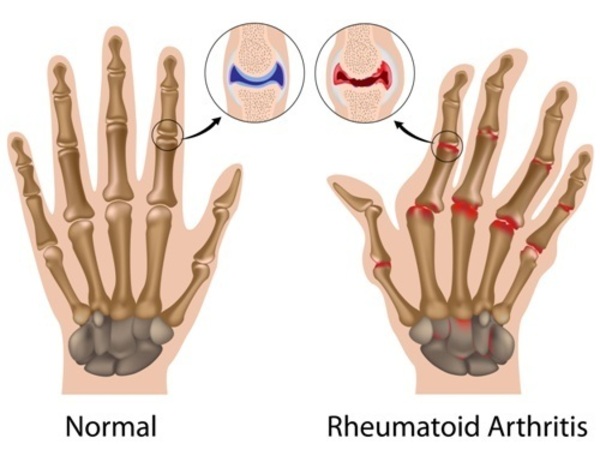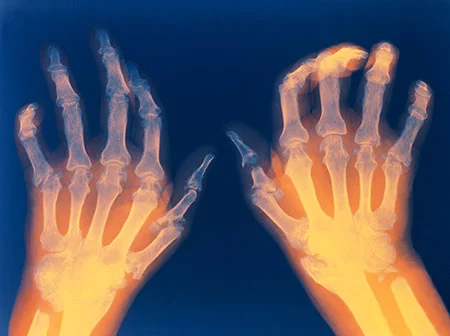Many people think that there is no cure to unbearable arthritis pain especially in case of osteoarthritis, but many people suffering from rheumatoid arthritis believe that change in their diet helped them get rid of the symptoms of rheumatoid arthritis and that also helped them continue with treatment for of rheumatoid arthritis on their own.
What is Arthritis ?
Arthritis refers to a range of conditions that involve pain and inflammation in the joints.

Is it a degenerative condition, which means the symptoms tend to worsen over time, or is it an autoimmune type of arthritis with associated extra-articular symptoms, characterized by inflammatory flares and a chronic clinical course?
These two types of arthritis include osteoarthritis (OA) and rheumatoid arthritis (RA).
OA mainly results when wear and tear of cartilage causes bones to rub together, leading to friction, damage, and inflammation.
RA is a systemic condition that triggers symptoms throughout the body. It’s an autoimmune disease and happens when the immune system mistakenly attacks healthy joint tissue.
Doctors can prescribe medication to relieve the pain of arthritis, but they often recommend natural approaches, too.
Remember to talk to your doctor before trying any remedy for arthritis, whether it involves medication or not.
Types of Arthritis
-
- Ankylosing spondylitis
- Gout
- Juvenile idiopathic arthritis
- Osteoarthritis
- Psoriatic arthritis
- Reactive arthritis
- Rheumatoid arthritis
- Septic arthritis
- Thumb arthritis
Symptoms of Arthritis
The most common signs and symptoms of arthritis involve the joints. Depending on the type of arthritis you have, your signs and symptoms may include:
-
- Pain
- Stiffness
- Swelling
- Redness
- Decreased range of motion
Causes of Arthritis
The two main types of arthritis — osteoarthritis and rheumatoid arthritis — damage joints in different ways.

Osteoarthritis
The most common type of arthritis, osteoarthritis involves wear-and-tear damage to your joint’s cartilage — the hard, slick coating on the ends of bones where they form a joint. Cartilage cushions the ends of the bones and allows nearly frictionless joint motion, but enough damage can result in bone grinding directly on bone, which causes pain and restricted movement. This wear and tear can occur over many years, or it can be hastened by a joint injury or infection.
Osteoarthritis also affects the entire joint. It causes changes in the bones and deterioration of the connective tissues that attach muscle to bone and hold the joint together. It also causes inflammation of the joint lining.

Rheumatoid Arthritis
In rheumatoid arthritis, the body’s immune system attacks the lining of the joint capsule, a tough membrane that encloses all the joint parts. This lining (synovial membrane) becomes inflamed and swollen. The disease process can eventually destroy cartilage and bone within the joint.
Natural Treatment of Arthritis
In case of arthritis the joints become painful, stiff and larger and the pain worsens with the passing day. The arthritis pain is hurting and an individual experiences unbearable pain when the joints get swollen or stiff and they are unable to carry out daily activities including simple tasks.
-
- A successful treatment which is all natural includes eliminating inflammatory foods from your diet.
- Secondly try and massage your joints or fingers using coconut oil (virgin) at least twice a day.
- Some of the supplements that help in reducing any type of arthritis pain are vitamin B12, sublingual methylcobalamin etc., you can dissolve these by keeping under your tongue, should not be chewed and you get vitamin D3 in form of capsules. You can take vitamin D3 naturally by getting your legs and arms exposed to sun.
- Diets which are acidic and are made from alive foods are inflammatory to your joints and other processes of your body. Eating a diet that comprises of living food like raw veggies, fruits, raw seeds, raw nuts etc helps get rid of osteoarthritis and in turn getting relief form unbearable arthritis pain. Diet changes works really good and you can the favorable diets at least for a month to see the changes.
If you are serious about eliminating arthritis pain from your life permanently then you need to go for major dietary changes with a commitment of consistency in following the diet. Exercise is the best option for your joints that are attacked by osteoarthritis, but you need to check with your health care provider. Keep moving as it is important and there are many exercises which you can try as a part of arthritis treatment keeping in mind how much you can move.
If you are suffering from arthritic pain in fingers, an exercise that includes putting together your finger tips, then press them hard and release them, repeat the same many times. Remember the easy way to fight arthritis is to keep moving and engaging yourself in exercise, so anyhow movement is important.
Once you are aware about arthritis may it be of any type, you can keep a check on the treatment program you are going to follow, whether it is a conventional or natural treatment or combining both to get maximum benefits. Before using any medications or drugs for arthritis, make sure you do a thorough research about it even if they are herbal medications. If you are using any drugs or medications, check with your pharmacists for related side effects, right dosage and related important information about the medication.
Once you know about arthritis, planning for a proper treatment would be easy.
Follow a healthy diet
A diet that’s rich in fresh fruits, vegetables, and whole foods can help boost your immune system and your overall health. There’s some evidence that dietary choices can affect people with both RA and OA.
A plant-based diet provides antioxidants, which can help reduce inflammation by eliminating free radicals from the body.
On the other hand, a diet rich in red meat, processed foods, saturated fat, and added sugar and salt may aggravate inflammation, which is a characteristic of arthritis.
These foods can also contribute to other health conditions, including obesity, high cholesterol, high blood pressure, heart disease, and other complications, so they’re likely not beneficial for people with arthritis.
Current OA guidelines do not recommend taking vitamin D or fish oil supplements as a treatment, but consuming foods containing these nutrients as part of a balanced diet may contribute to overall well-being.
Consider herbal supplements
Many herbal supplements may reduce joint pain, although scientific research hasn’t confirmed that any specific herb or supplement can treat arthritis.
Some of these herbs include:
-
- boswellia
- bromelain
- devil’s claw
- ginkgo
- stinging nettle
- thunder god vine
The Food and Drug Administration (FDA) doesn’t monitor herbs and supplements for quality, purity, or safety, so you cannot be sure exactly what a product contains. Be sure to buy from a reputable source.
Always talk to your doctor before trying a new supplement, as some can cause side effects and dangerous drug interactions.
Arthritis Medications
The medications used to treat arthritis vary depending on the type of arthritis. Commonly used arthritis medications include:
- Painkillers. These medications help reduce pain, but have no effect on inflammation. An over-the-counter option includes acetaminophen (Tylenol, others).For more-severe pain, opioids might be prescribed, such as tramadol (Ultram, ConZip), oxycodone (OxyContin, Roxicodone, others) or hydrocodone (Hysingla, Zohydro ER). Opioids act on the central nervous system to relieve pain. When opioids are used for a long time, they may become habit-forming, causing mental or physical dependence.
- Nonsteroidal anti-inflammatory drugs (NSAIDs). NSAIDs reduce both pain and inflammation. Over-the-counter NSAIDs include ibuprofen (Advil, Motrin IB, others) and naproxen (Aleve). Some types of NSAIDs are available only by prescription.Oral NSAIDs can cause stomach irritation and may increase your risk of heart attack or stroke. Some NSAIDs are also available as creams or gels, which can be rubbed on joints.
- Counterirritants. Some varieties of creams and ointments contain menthol or capsaicin, the ingredient that makes hot peppers spicy. Rubbing these preparations on the skin over your aching joint may interfere with the transmission of pain signals from the joint itself.
- Disease-modifying antirheumatic drugs (DMARDs). Often used to treat rheumatoid arthritis, DMARDs slow or stop your immune system from attacking your joints. Examples include methotrexate (Trexall, Rasuvo, others) and hydroxychloroquine (Plaquenil).
- Biologic response modifiers. Typically used in conjunction with DMARDs, biologic response modifiers are genetically engineered drugs that target various protein molecules that are involved in the immune response.There are many types of biologic response modifiers. Tumor necrosis factor (TNF) inhibitors are commonly prescribed. Examples include etanercept (Enbrel, Erelzi, Eticovo) and infliximab (Remicade, Inflectra, others).Other medications target other substances that play a role in inflammation, such as interleukin-1 (IL-1), interleukin-6 (IL-6), Janus kinase enzymes, and certain types of white blood cells known as B cells and T cells.
- Corticosteroids. This class of drugs, which includes prednisone (Prednisone Intensol, Rayos) and cortisone (Cortef), reduces inflammation and suppresses the immune system. Corticosteroids can be taken orally or can be injected directly into the painful joint.